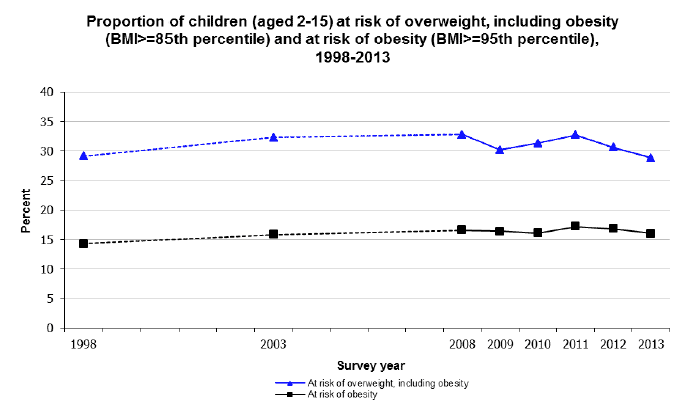Obesity Indicators 2014
This publication reports the latest available data for 16 indicators selected to monitor progress for the Prevention of Obesity Route Map. Most indicators are updated up to 2013, but for some indicators data is more or less up-to-date than this.
Proportion of children at risk of overweight and obesity
Indicator Source: Scottish Health Survey
LATEST RESULTS
In 2013, nearly one in six (16.0%) children aged 2 to 15 were at risk of obesity (at or above the 95th percentile), with a further 12.8% at risk of overweight (at or above the 85th percentile, and below the 95th).
The proportion of children at risk of overweight (including obesity) in 2013 was 28.8%. Prevalence was highest in 2008 (32.8%) and 2011 (32.7%) and lowest in 2013. The decrease between 2011 and 2013 was not statistically significant.
The 2013 figure for overweight (including obesity) in boys (30.9%) was higher than for girls (26.6%), although this difference was not significant. Prevalence was highest among those children aged 12 to 15 (30.8%).
A third (34.0%) of boys aged 7-11 were at risk of overweight including obesity. The equivalent figure for girls of the same age was 24.8%.

ABOUT THIS INDICATOR
Desired Outcome:
Fewer children in Scotland overweight and obese.
Definitions:
At risk of overweight (including obesity) - BMI at or above 85th percentile
At risk of obesity - BMI at or above 95th percentile.
(Based on UK 1990 reference chart cut-offs).
Geography available:
National, Health Board.
Equalities data:
Breakdowns by four equalities groups may be possible (sexual orientation and religion are not asked of children), but not all are available annually.
Rationale for including this indicator:
The aim of this indicator is to monitor changes in the proportion of Scotland's children who are overweight and obese. It is used to identify any different patterns (and hence need for specific policy focus) amongst children of different ages. It is a long term measure of success of the Route Map.
As the proportion of overweight and obesity in children is measured against a reference population, by definition we would expect 15% to be overweight (including obese) and 5% to be obese.
Factors influencing this indicator[3]:
- Parental BMI; children of parents who are of a healthy weight or underweight are less likely to be overweight or obese than children of obese parents.
- Area deprivation; children in the 15% most deprived areas of Scotland are significantly more likely to be obese than those living elsewhere (18.7% compared to 14.5%).
- Household income; boys in the lowest income households are more likely than those in other households to be obese. There is no clear association for girls.
Contact
Email: Daniel Adams
There is a problem
Thanks for your feedback